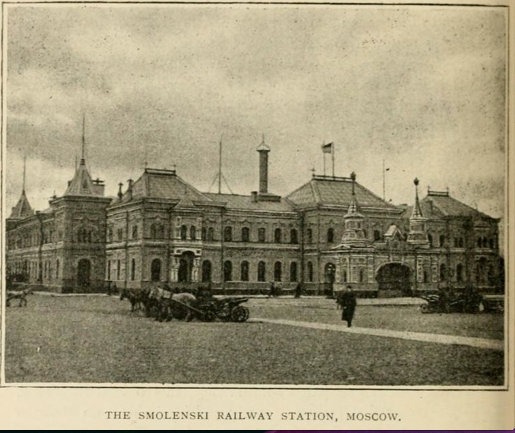Harold Frederic, a New York Times reporter whose dispatches from Russia were
collected and published as a book in 1892, watched the scenes at the railway
station when the tightly packed Third Class carriages left Moscow. Almost all
refugees took the slow, inexpensive train that left the Smolensk Station at 7 p.m.
each evening:
 The long, broad platform was dotted with
piles of their luggage heaped against the
walls... There were pet pieces of furniture
wrapped up in sheets and crockery encased
in bedding and tied with ropes. One saw
carpets, picture-frames, candlesticks, big
leather-bound books, even birdcages, all
made into parcels as portable as possible...
Everywhere there were teapots fastened
outside the hand luggage, so as to be easy of
access during the wearisome journey...
(1892, p.199)
The long, broad platform was dotted with
piles of their luggage heaped against the
walls... There were pet pieces of furniture
wrapped up in sheets and crockery encased
in bedding and tied with ropes. One saw
carpets, picture-frames, candlesticks, big
leather-bound books, even birdcages, all
made into parcels as portable as possible...
Everywhere there were teapots fastened
outside the hand luggage, so as to be easy of
access during the wearisome journey...
(1892, p.199)
Frederic not only described day-to-day reality as the Moscow Evictions progressed,
but also reported on the experiences of refugees who emigrated, travelling from
central
Russia to the German port of Hamburg. The "New Exodus," as the New York
Times called it, began in June of 1891. During that summer, between two and three
thousand families per week received help from the Hamburg Jewish community. In
July, volunteers served 14,128 meals to Jewish families waiting at the port; 23,579
were served in August. According to Frederic, the numbers peaked on 4 August,
when 1,360 refugees were fed in one day. Of particular interest to family researchers
is Frederic's list of 88 persons evicted from Moscow in 1891, naming their towns of
origin in the Pale (1892, pp.291-292).
Sources and Further Reading
Harold Frederic's original dispatches are reprinted in the New York Times archive.
See, for example "AN INDICTMENT OF RUSSIA" by (London Correspondent) Harold
Frederic, The New York Times, 7 December 1891, p. 1.
Frederic's book, The New Exodus: A Study of Israel in Russia (1892) is available in
digital form (free of charge) through The Internet Archive.
Map Showing the Percentage of Jews in the Pale of Settlement and Congress Poland
from The Jewish Encyclopedia, 1905. In public domain, via Wikimedia Commons
from Wikimedia Commons.
Map of European Railroad Routes and Stations, with inset showing Moscow-St.
Petersburg line. Courtesy of David Rumsey Historic Map Collection.
1914 - 1936 Recovery, Then Purges
|



